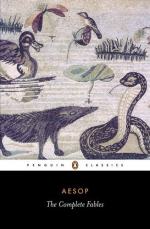|
This section contains 2,881 words (approx. 10 pages at 300 words per page) |

|
SOURCE: "The Latin Aesop of Ermolao Barbaro," in Manuscripta, Vol. XXII, No. 3, November 1978, pp. 141-48.
In the following essay, Berrigan looks at the Italian Renaissance tradition of teaching languages as well as morals via translations of Aesop's works.
The Latin translators of Aesop in the first half of the Quattrocento comprise a small group of Italians, whose contributions to the field of fable literature have been the subject of study for the past century by both classical and Renaissance scholars. A particularly significant cluster of articles has been authored by Professor Chauncey E. Finch.1 Before taking up Ermolao Barbaro and his apologues, I would like to provide the context of the Renaissance fable and the several men who busied themselves with Aesop in the early Quattrocento.
Our starting point has to be that the fable played a significant role in early Byzantine education as well as in the...
|
This section contains 2,881 words (approx. 10 pages at 300 words per page) |

|


